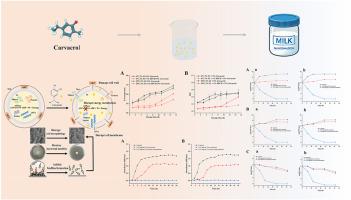Improving the bactericidal activity of carvacrol against Bacillus cereus by the formation of sodium casein-stabilized nanoemulsion and its application in milk preservation
IF 11
1区 农林科学
Q1 CHEMISTRY, APPLIED
引用次数: 0
Abstract
Carvacrol has great antibacterial activity against Bacillus cereus, and its action mechanism was comprehensively studied in this work. It could not only control the growth of B. cereus by affecting the integrality of cellular structure and physiological metabolism, but also inhibit the swarming motility, biofilm formation, and toxins production. To increase the stability of carvacrol during the application, the sodium casein (SC)/hydroxypropyl-β-cyclodextrin (HPCD)/carvacrol nanoemulsion was fabricated. The mean particle size and polydispersity index of the nanoemulsions were 113.8 nm and 0.23, respectively, at SC and HPCD concentrations of 2% and 1%. FTIR analysis demonstrated that carvacrol was successfully encapsulated into the nanoemulsions. The MIC and MBC of nanoemulsions against B. cereus were 0.15 and 0.30 mg/mL, respectively, which were lower than those of free carvacrol (0.19 and 0.38 mg/mL). Carvacrol in nanoemulsions showed a slow and sustained release behavior. Furthermore, the nanoemulsions had good stability (particle size <200 nm) after storage at 4 °C and 25 °C for 15 days. Notably, the nanoemulsions were effective in controlling the growth of B. cereus in whole, low-fat, and skim milk and had better antimicrobial activity than free carvacrol. The results indicated that carvacrol nanoemulsions have potential in the antibacterial application of the food industry.

通过形成酪蛋白钠稳定纳米乳液提高香芹酚对蜡样芽孢杆菌的杀菌活性及其在牛奶保存中的应用
香芹酚对蜡样芽孢杆菌具有很强的抗菌活性,本研究对其作用机理进行了全面研究。它不仅能通过影响细胞结构和生理代谢的整体性来控制蜡样芽孢杆菌的生长,还能抑制其蜂拥运动、生物膜的形成和毒素的产生。为了提高香芹酚在应用过程中的稳定性,制备了酪蛋白钠(SC)/羟丙基-β-环糊精(HPCD)/香芹酚纳米乳液。当 SC 和 HPCD 的浓度分别为 2% 和 1% 时,纳米乳液的平均粒径和多分散指数分别为 113.8 nm 和 0.23。傅立叶变换红外分析表明,香芹酚被成功地包裹在纳米乳液中。纳米乳剂对蜡样芽孢杆菌的 MIC 和 MBC 分别为 0.15 和 0.30 mg/mL,低于游离香芹酚的 MIC 和 MBC(0.19 和 0.38 mg/mL)。纳米乳剂中的香芹酚表现出缓慢而持续的释放行为。此外,纳米乳剂在 4 °C 和 25 °C 下储存 15 天后具有良好的稳定性(粒径为 200 nm)。值得注意的是,纳米乳剂能有效控制全脂奶、低脂奶和脱脂奶中蜡样芽孢杆菌的生长,其抗菌活性优于游离香芹酚。结果表明,香芹酚纳米乳剂在食品工业的抗菌应用中具有潜力。
本文章由计算机程序翻译,如有差异,请以英文原文为准。
求助全文
约1分钟内获得全文
求助全文
来源期刊

Food Hydrocolloids
工程技术-食品科技
CiteScore
19.90
自引率
14.00%
发文量
871
审稿时长
37 days
期刊介绍:
Food Hydrocolloids publishes original and innovative research focused on the characterization, functional properties, and applications of hydrocolloid materials used in food products. These hydrocolloids, defined as polysaccharides and proteins of commercial importance, are added to control aspects such as texture, stability, rheology, and sensory properties. The research's primary emphasis should be on the hydrocolloids themselves, with thorough descriptions of their source, nature, and physicochemical characteristics. Manuscripts are expected to clearly outline specific aims and objectives, include a fundamental discussion of research findings at the molecular level, and address the significance of the results. Studies on hydrocolloids in complex formulations should concentrate on their overall properties and mechanisms of action, while simple formulation development studies may not be considered for publication.
The main areas of interest are:
-Chemical and physicochemical characterisation
Thermal properties including glass transitions and conformational changes-
Rheological properties including viscosity, viscoelastic properties and gelation behaviour-
The influence on organoleptic properties-
Interfacial properties including stabilisation of dispersions, emulsions and foams-
Film forming properties with application to edible films and active packaging-
Encapsulation and controlled release of active compounds-
The influence on health including their role as dietary fibre-
Manipulation of hydrocolloid structure and functionality through chemical, biochemical and physical processes-
New hydrocolloids and hydrocolloid sources of commercial potential.
The Journal also publishes Review articles that provide an overview of the latest developments in topics of specific interest to researchers in this field of activity.
 求助内容:
求助内容: 应助结果提醒方式:
应助结果提醒方式:


